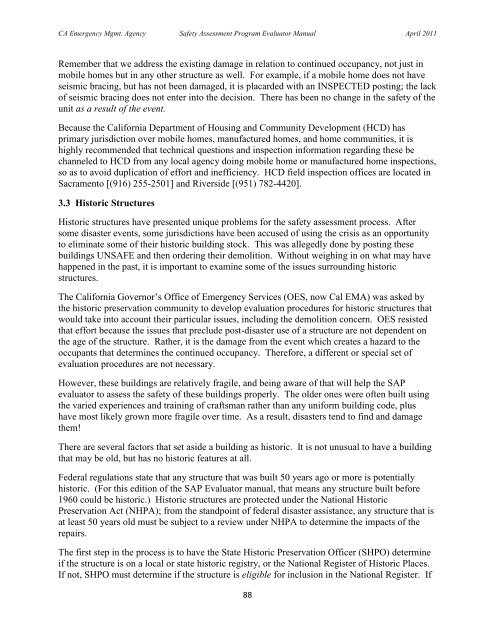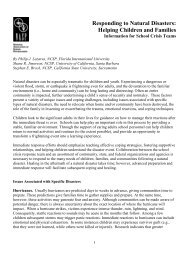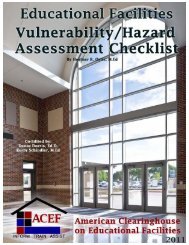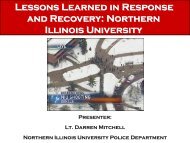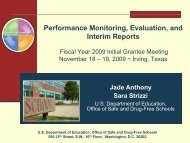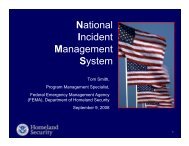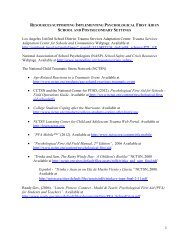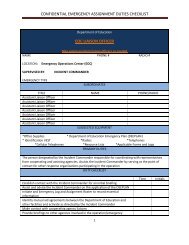Safety Assessment Program Evaluator Student Manual
Safety Assessment Program Evaluator Student Manual
Safety Assessment Program Evaluator Student Manual
You also want an ePaper? Increase the reach of your titles
YUMPU automatically turns print PDFs into web optimized ePapers that Google loves.
CA Emergency Mgmt. Agency <strong>Safety</strong> <strong>Assessment</strong> <strong>Program</strong> <strong>Evaluator</strong> <strong>Manual</strong> April 2011Remember that we address the existing damage in relation to continued occupancy, not just inmobile homes but in any other structure as well. For example, if a mobile home does not haveseismic bracing, but has not been damaged, it is placarded with an INSPECTED posting; the lackof seismic bracing does not enter into the decision. There has been no change in the safety of theunit as a result of the event.Because the California Department of Housing and Community Development (HCD) hasprimary jurisdiction over mobile homes, manufactured homes, and home communities, it ishighly recommended that technical questions and inspection information regarding these bechanneled to HCD from any local agency doing mobile home or manufactured home inspections,so as to avoid duplication of effort and inefficiency. HCD field inspection offices are located inSacramento [(916) 255-2501] and Riverside [(951) 782-4420].3.3 Historic StructuresHistoric structures have presented unique problems for the safety assessment process. Aftersome disaster events, some jurisdictions have been accused of using the crisis as an opportunityto eliminate some of their historic building stock. This was allegedly done by posting thesebuildings UNSAFE and then ordering their demolition. Without weighing in on what may havehappened in the past, it is important to examine some of the issues surrounding historicstructures.The California Governor‟s Office of Emergency Services (OES, now Cal EMA) was asked bythe historic preservation community to develop evaluation procedures for historic structures thatwould take into account their particular issues, including the demolition concern. OES resistedthat effort because the issues that preclude post-disaster use of a structure are not dependent onthe age of the structure. Rather, it is the damage from the event which creates a hazard to theoccupants that determines the continued occupancy. Therefore, a different or special set ofevaluation procedures are not necessary.However, these buildings are relatively fragile, and being aware of that will help the SAPevaluator to assess the safety of these buildings properly. The older ones were often built usingthe varied experiences and training of craftsman rather than any uniform building code, plushave most likely grown more fragile over time. As a result, disasters tend to find and damagethem!There are several factors that set aside a building as historic. It is not unusual to have a buildingthat may be old, but has no historic features at all.Federal regulations state that any structure that was built 50 years ago or more is potentiallyhistoric. (For this edition of the SAP <strong>Evaluator</strong> manual, that means any structure built before1960 could be historic.) Historic structures are protected under the National HistoricPreservation Act (NHPA); from the standpoint of federal disaster assistance, any structure that isat least 50 years old must be subject to a review under NHPA to determine the impacts of therepairs.The first step in the process is to have the State Historic Preservation Officer (SHPO) determineif the structure is on a local or state historic registry, or the National Register of Historic Places.If not, SHPO must determine if the structure is eligible for inclusion in the National Register. If88


